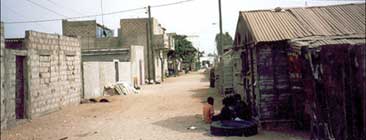|
Context Summary
Senegal has an estimated population of about nine million people (2001). Although overwhelmingly agricultural, Senegal has a growing industrial sector. The economy remains largely dependent on a single crop: peanuts. The Human Development Index (HDI) rank Senegal 156 out of the 174 counties listed.
Senegal’s annual population growth (1995-2000) is 2.6 percent and more than 4 percent in the capital, Dakar. It is estimated that 47 percent of the Senegalese population lives in urban areas. Dakar is the largest city and the principal port and commercial center and has 50 percent (about two million) of the total urban population of the country. 25 percent of Senegal’s urban zones have been illegally occupied, particularly in the Dakar area where nearly 30 percent of the urban population lives in unplanned areas.
Senegal has been implementing a national urban upgrading and land legalization policy since 1987 in order to respond to the rapid and uncontrolled urban growth of its sprawling squatter areas. An earlier policy of slum evictions had failed, but slum clearance policies pushed the poor population towards the periphery, which are under-equipped and, because they are considered illegal, no infrastructure has been built.
In Dakar, the Dalifort quarter was the site of the pilot upgrading project assisted by the GTZ; from which came the name, “Dalifort methode." The two main objectives in this approach, urban upgrading and land legalization tenure, are supported by community participation in all processes, and by cost-recovery, which permits the replication of the intervention. Its success became the reference model for other upgrading projects. Some professionals consider the complete replicability and the follow-up on a large scale difficult, particularly because of the continuing need for technical assistance and the consequent high cost.
Lessons from Recent Projects - Summary
Urban Upgrading
- Urban upgrading must be disassociated from land legalization. Past projects show that urban upgrading and land legalization have dissimilar “rhythms." A timetable can be applied to planned urban upgrading activities with the implementation of work by an enterprise; however, land legalization, under the control of a national or local administration, can be affected by uncontrollable delays.
- Primary and tertiary infrastructure should also be disassociated. Primary infrastructure is based on technical and political decisions and has to be accomplished first, with a non-financial contribution required from the stakeholders. Community participation is reserved for the secondary and tertiary infrastructures in the definition of priorities, levels of infrastructure, design, and financial participation. For future projects five phases are proposed, the first one to focus on the principal infrastructure and the later phases on the process of participation for the secondary and tertiary infrastructure and for land legalization.
- The Dalifort team believed that involving small enterprises could ameliorate the quality of work and reduce delays. The inhabitants of Dalifort participated physically in the work in order to reduce the cost of the project; however, in some cases, this was detrimental to the quality of achievement.
- Upgrading is facilitated if the stakeholders displaced by the project are resettled in the same neighborhood.
- Compensation for the displaced depends on the material of the existing houses. Dalifort dwellers were helped by the community to move their wooden constructions. In Medina Fass-M’Bao, the stakeholders received financial compensation for the demolition of their houses.
Land Legalization
- Land legalization was the main component of the Dalifort method, and a response to the insecure land occupancy provoked by the previous national slum clearance policy. When neighborhood upgrading has begun, the community was less interested in receiving the title for the land. Security of tenure need not necessarily involve the issuing of land title through a title deed.
- The original approach assumed an urgent need by stakeholders for a “droit de superficie” and linked the payment for the plots with the legal procurement of this right.
- The procedure for land legalization failed in terms of the low rate of payment for the plots, at least in the short term after the close of the project.
- Stakeholders feel secure about their land occupancy in an upgraded neighborhood, and the population is investing in houses and is improving the area.
- Large-scale legalization procedures are long and complex. Procedures need to be simplified and adapted, and it is equally necessary to ensure coordination between the different agencies involved.
- Community Participation
- Community participation has permitted the creation of an identity in each quarter. It is an important intermediary between the inhabitants and other entities.
- Although participation in the implementation is possible in some sites, especially in the task of clearing public roads, experience has shown that all civil engineering work must be left to professionals.
Cost Recovery
- The principle of linking the dimension of intervention with the level of savings of the population has limits for low-income populations. On the other hand, financial participation has shown a real impact on the sustainability of the interventions.
- Cost recovery is difficult if it is implemented after the upgrading of the neighborhood, and if the only benefit is the acquisition of the “droit de superficie.”
- For DUA/GTZ team, cost recovery from beneficiaries of the project is more a matter of time and formalization than of beneficiaries accepting the principle of participation which has been widely supported. There are no sanctions if there is no payment. The payment is linked only to obtaining the land title.
- There is a correlation between the rhythm of the work and the rhythm of the contributions from the inhabitants.
Partnerships
- In past projects, the municipalities were not involved, and the participatory methodology was focused on the communities. However, decentralization in 1996 has changed the institutional context for future projects.
|


